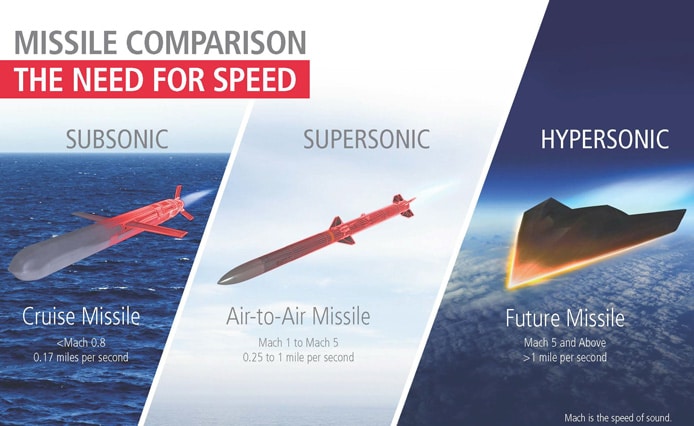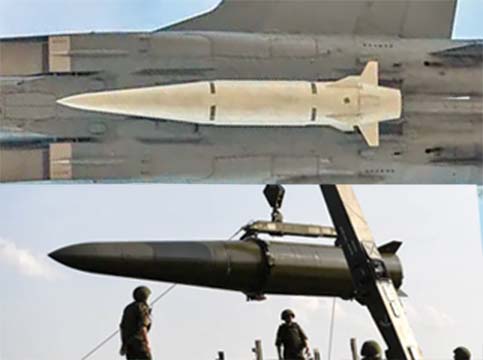Alex Hollings

Hypersonic is a term first popularized in the 1970s (though its earliest use seems to date back to 1946, at least). It describes any vehicle that travels at Mach 5 or faster. Or, at least, that’s the simple version of the definition.
To get technical, hypersonic really just means high-supersonic, as the hypersonic barrier is actually a notional one, unlike the supersonic barrier, which is physical.
Put simply, air behaves differently when passing from subsonic to supersonic speeds, creating new challenges for vehicles designed to surpass the sound barrier. The challenges of hypersonic flight aren’t different from those of lower supersonic flight, they’re just way worse.
The air resistance experienced by a vehicle increases in proportion to its velocity squared. This means that as the speed of the vehicle increases, the pressure and friction its subjected to don’t increase gradually, but exponentially.
As a result, back in 2007, NASA defined the word hypersonic as the realm of flight where air resistance becomes the biggest problem to address, which happens to be at around Mach 5.
“Hypersonics is the study of flight at speeds where aerodynamic heating dominates the physics of the problem. Typically this is Mach 5 and higher.”“Facing the Heat Barrier: A History of Hypersonics” by T. A. Heppenheimer for NASA
So, while the supersonic barrier marks a physical difference in how a vehicle interacts with the air it passes through, the hypersonic barrier is an imaginary one, used simply as a way of demonstrating how significant the increase in air resistance really is at these speeds.
Missiles that fly faster than Mach 5 have been around since 1949
 A photo of a V-2 with a WAC Corporal Rocket mounted on top taken in July of 1950 (NASA)
A photo of a V-2 with a WAC Corporal Rocket mounted on top taken in July of 1950 (NASA)The above may seem like semantics, but a lack of hypersonic understanding has led to an increasingly prevalent idea that modern hypersonic missiles are special because they’re fast. The truth is, speed isn’t the cutting edge part of hypersonics at all.
In fact, achieving hypersonic speeds with missiles and rockets has been commonplace since mankind first started fielding rockets with multiple stages. The first meaningful effort to field a two-stage rocket took place in February of 1949 on the White Sands Proving Ground (now the White Sands Missile Range) in New Mexico, with a thin WAC Corporal rocket mounted atop a modified German V-2. This successful launch proved that multi-stage rockets could be effective and featured the first man-made object to achieve hypersonic speeds.
Since then, just about every rocket, ballistic missile, and re-usable spacecraft has been hypersonic, including America’s standing arsenal of half-century-old Minuteman III ICBMs, which regularly achieve speeds as high as Mach 24 upon re-entry. There are even re-usable hypersonic platforms that you’re almost certainly familiar with, like the Space Shuttle, the Air Force’s X-47B, and SpaceX’s Dragon crew capsule.
All the way back in 1967, test pilot William “Pete” Knight flew his North American X-15 at Mach 6.7, making him the first person to fly at hypersonic speeds, but more than a decade before that (and even before the launch of Sputnik 1) the U.S. already had a hypersonic bomber program in development. Speed is a tough engineering hurdle to manage, but it’s one the United States has a long history of overcoming.
Modern hypersonic missiles like Russia’s Avangard or China’s DZ-ZF anti-ship weapon are indeed fast. But modern air defenses have been using complex mathematical equations to intercept fast-moving missiles for years now. What makes these modern weapons special isn’t their speed alone, but their ability to maneuver unpredictably at those high speeds.
That maneuverability is actually what makes modern hypersonic weapons special. Hypersonic boost-glide systems are quite a bit like their (technically hypersonic) ICBM precursors. They’re carried aloft by rockets just like an ICBM warhead, before detaching and gliding unpowered down toward their targets. During that unpowered descent, however, boost-glide weapons use chemical thrusters, moving-control surfaces, or both to change course. It’s those course changes that render the calculations air defense systems use for intercepts useless.
In order to intercept a missile, you have to know where it will be farther along its flight path so you can launch an interceptor (another missile) to meet it there. If the boost-glide weapon changes course, its flight path is no longer predictable, and intercepting becomes a far more complex proposition.
Countries (and even some media outlets) intentional mislead you about hypersonics
 Russia’s Kh47M2 Kinzhal mounted on the belly of a MiG-31 (Wikimedia Commons)
Russia’s Kh47M2 Kinzhal mounted on the belly of a MiG-31 (Wikimedia Commons)Now that we know that our modern use of the phrase “hypersonic missile” is specifically referring to weapons that can maneuver at hypersonic speeds (otherwise ICBMs and similar weapons would be lumped into the same category), we can better appreciate how countries like Russia have leveraged confusion about the term to their own advantage.
In 2018, Russian President Vladimir Putin gave a speech in which he announced a bevy of new Russian missiles. These included what Moscow called the world’s first operational “hypersonic missile,” the Kh47M2 Kinzhal, followed by the Avangard boost-glide system the following year. In the minds of many, this speech kicked off the modern hypersonic arms race, with Russia already positioned in the lead.
Then, in February of 2022, the world once again took notice as Russia became the first nation to use a “hypersonic weapon” in combat, as the Kremlin announced two different launches of Kinzhal missiles against targets in Ukraine. Just as in 2018, these launches drew a tidal wave of headlines highlighting Russia’s advanced missile programs.
As we’ve discussed at length before, Russia’s Kh47M2 Kinzhal is nothing more than an air-launched ballistic missile that achieves hypersonic speeds in the same fashion all ballistic missiles do… via rocket propulsion and a ballistic flight path. The Kinzhal missile is actually a modified 9K720 Iskander short-range ballistic missile the Soviets began development in 1988, with a new targeting system added for air-to-ground operations.

Top: Kh-47M2 Kinzhal, Bottom: Iskander-M short range ballistic missile.
But Russia knew the world wasn’t entirely clear on the difference between a ballistic missile like Kinzhal (or even a modified AIM-54 Phoenix missile) achieving hypersonic speeds and modern maneuverable hypersonic weapons. So they simply branded their Kinhzal missile as “hypersonic” and watched as the world bought it.
Russia is still often thought of as the first country to field a hypersonic weapon and the first to use one in combat. The truth is, China’s DZ-ZF was the world’s first operational modern hypersonic weapon. If you prefer Russia’s more simplistic approach to labeling anything that breaks Mach 5 as a hypersonic missile, however, then it would be America’s PFM-11 Redstone from 1950. In either case, Russia doesn’t make the list.
Some media outlets buy into Russia’s hypersonic branding because of bias, others because of sensationalism, and certainly some simply because of a lack of understanding. At the end of the day, hypersonic simply became such a powerful buzzword that its actual meaning proved less useful than the prevalent misconception.
No comments:
Post a Comment